-
Our Community
-
- Our Community About Florence City Newsletter News & Recognition Events & Activities City Calendar Florence Events Center Calendar Chamber Calendar RiverCal Siuslaw Library Calendar Schools Siuslaw School District Lane Community College
- Airport City Projects Directory Doing Business Health Care Resources Library Local Media Rainfall Report Transportation Parks & Trails Directory
- Public Safety City of Florence Police Lane County Sheriff's Office Oregon State Police US Coast Guard - Siuslaw Station Western Lane Fire & EMS Authority Organizations Florence Area Chamber of Commerce Florence Events Center Florence Senior Center Port of Siuslaw Siuslaw Vision
-
- Doing Business
-
Welcome Visitors
-
- About Florence Community Amenities Airport Florence Events Center Library Parks & Trails Directory Public Art Senior Center
- Eat, Shop, Stay & Play Florence Area Chamber of Commerce Move Your Business
- Events & Activities City Calendar Siuslaw Library Calendar Chamber Calendar Florence Events Center Calendar
-
-
Inside City Hall
-
- City Council City Services A-Z Commissions and Committees City Projects Directory Agendas and Minutes Florence News ADA Facility Code of Conduct
- Administration Administrative Services City Manager's Office City Recorder Economic Development Emergency Management Finance Human Resources Municipal Court Urban Renewal (FURA) Utility Billing Florence Events Center Police
- Community Development Building Code Enforcement Planning & Zoning Public Works Airport Parks Stormwater Streets Wastewater Water Media Inquiries
-
-
Helpful Resources
-
- Apply for a Job Apply for a Board or Committee Contact the City Council Contact City Staff Check City Social Media Download Forms & Applications Find a City Code
- Find Transportation Get a Business License Get a Noise Variance Get Email Subscriptions Hold a Special Event Locate City Offices Pay My Utility Bill Pay My Court Fine
- Report a Code Violation Report Storm Related Issues Request a Police Report Request a Public Record Reserve a Park View Bids & RFPs View the Calendar
-
Wastewater Treatment Plant UV Disinfection System Improvement Project
Project Type:
Sewer and Wastewater
Project Status:
Under Construction
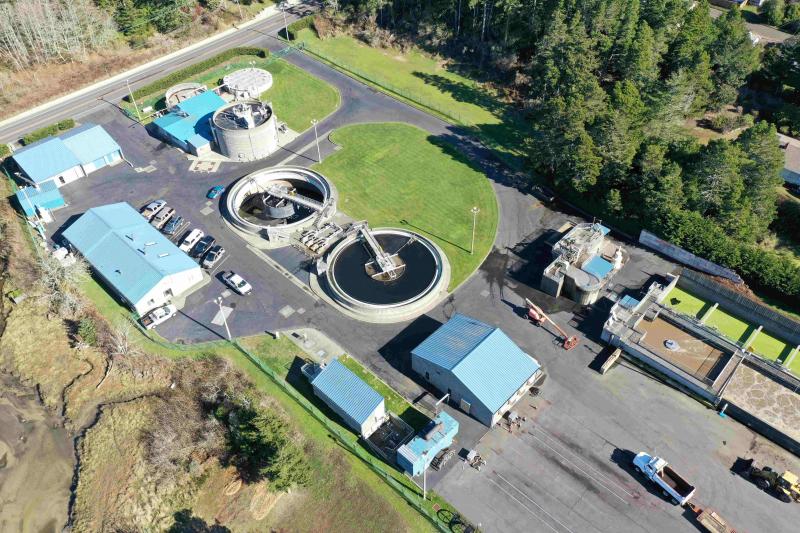
Disinfection is considered to be the primary mechanism for the activation and destruction of pathogenic organisms to prevent the spread of waterborne diseases to downstream users and the environment. It is important that wastewater be adequately treated prior to disinfection in order for any disinfectant to be effective. The City switched from chlorine to UV for disinfection of the treated effluent prior to discharge into the Siuslaw River in 1999.
In UV wastewater disinfection technology, UV light is used for the disinfection of bacteria, viruses, molds, algae and other microorganisms. UV light disinfects by penetrating microorganisms and destroying their genetic material (DNA and RNA). DNA and RNA plays an important role in organisms’ functions and reproduction; destroying the DNA prevents the organism from growing and multiplying. In wastewater treatment, one microorganism that is of specific importance is fecal coliform. Fecal coliforms are used as indicator organisms for fecal contamination. If fecal coliform is present in a wastewater treatment plant effluent, then it can be assumed that other harmful forms of microorganisms are too. A high level of fecal coliform can also mean that the UV disinfection system is not functioning properly.
An UV disinfection system is not simply a lamp inside a channel. The four basic parts of a UV system include the lamp, quartz sleeve, reactor and ballast. The ballast controls the UV bulbs which are housed in a quartz sleeve. The area that contains the bulbs is the reactor. The system that the City utilizes is a parallel contact type reactor where the UV lamps are in the quartz sleeves are submerged into the wastewater effluent which is parallel to the direction of flow and weirs are used to control the level of wastewater.
Contact UV disinfection systems are designed to ensure that all microbes receive sufficient exposure to the UV light. Based on the hydraulic properties of water, the reactor needs to be optimized to guide the flow in a manner to maximize contact time and turbulence. Along with hydraulic properties, UV transmittance (UVT) is a measurement used to determine how much UV light passes through a sample of water compared to distilled water. Dissolved organics, suspended particulates, color, and certain UV light absorbing metals are the main absorbers of UV light.
Status Updates
August 15th, 2025
After a successful seven-day operational test of the new UV system, the contractor and Wastewater Treatment Plant operators set up the bypass system to remove the knockout panel between the new UV channel and the existing effluent discharge channel.
While bypassed, effluent was stored in the reserve clarifier and east aeration basin (both designed for future capacity). Once the panel was removed, the 21-day acceptance test began. Stored effluent is now being returned to the UV system for disinfection before release into the Siuslaw River.
Performance results have been exceptional: a pre-disinfection effluent sample measured 92,000 Most Probable Number (MPN) fecal coliform per 100 milliliters (mL); post-disinfection, the result was 0 MPN—a flawless outcome.

July 18th, 2025
The UV Disinfection Improvements project at the WWTP is in the testing phase. The contractor and the equipment manufacturer are on site testing the new equipment so that it can be commissioned within the next several weeks. The process of commissioning lasts for twenty one days to verify that the new system will function as designed for many years to come.
April 25th, 2025
Our contractor, Strider, is officially offsite and the project is on hold until they remobilize on June 10th. We anticipate that the UV manufacturer will be onsite towards the end of June/first of July for the equipment startup and commissioning. Project is expected to be 100% complete by August 15, 2025.
April 18th, 2025
Our contractor, Strider, is still wrapping up items before we pause the project for the equipment manufacturer to complete the startup and commissioning of the equipment at the end of June.
April 11th, 2025
Our contractor, Strider, is wrapping up items that can be completed before we pause the project for the equipment manufacturer to complete the startup and commissioning of the equipment at the end of June. The contractor has backfilled against the new UV channel and is finalizing cover plate supports and cable routing.
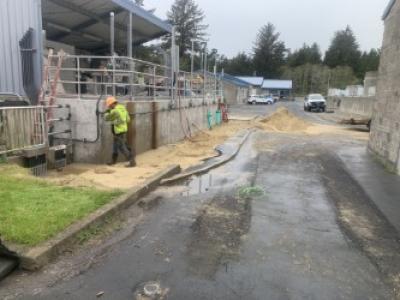
February 21st, 2025
Our contractor, Strider Construction, installed the safety railing around the perimeter of the new effluent channel where the UV disinfection equipment will be installed.
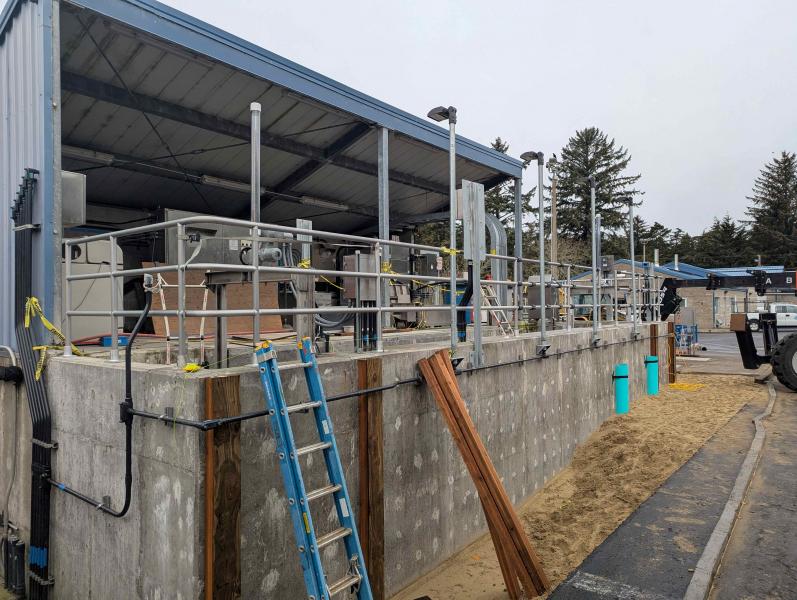
January 31st, 2025
Our contractor completed the third shut down and bypass of the existing UV disinfection system. Work this time centered around grouting of the new slide gates and preparation of north bulkhead. The electrical contractor has completed all of the work they can perform until such time that the cat walks are installed and the new UV equipment arrives.
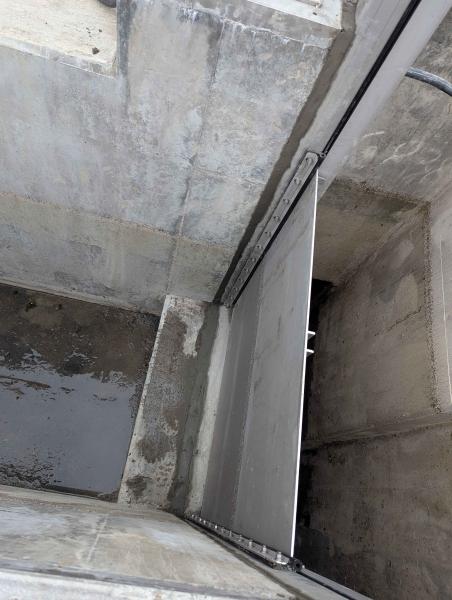
January 24th, 2025
Our contractor completed the second shut down and bypass of the existing UV disinfection system. As reported last week, the first plant shut down allowed the contractor to cut out the ‘knock out’ panels in order to create an opening into the existing channel to allow the flow of effluent from the existing channel into the new channel. With the fasteners and anchors for the new slide gates in place, the contractor installed the new slide gates. This marks a significant milestone for the project.
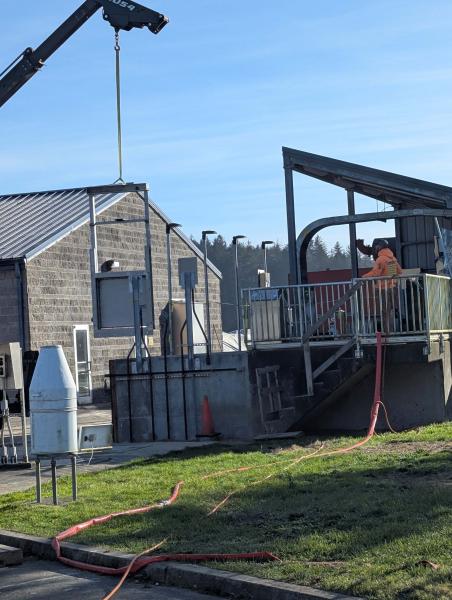
January 17th, 2025
It has been a while since we reported on the progress of the UV Disinfection System Project. With the concrete channel finally complete and the concrete cured, it is time to cut an opening into the existing channel to allow the flow of effluent from the existing channel into the new channel. This way the existing system can remain in operation in the future to provide additional disinfection capacity and backup. In order to open up the existing channel, the contractor needed to by-pass the existing UV system in order to dewater the facility. The contractor brought in high-capacity pumps to pump down Clarifier 1 and transfer the water into Clarifier 2 and the second aeration basin. Once the existing UV system channel had been dewatered, the contractor cut out the section of concrete, knock out panel, to allow the installation of the new gates. With the knock out panel removed, the contractor was able to complete the next step of the process and install the fasteners and anchors for the new slide gate so that we can isolate the two systems.
With the first of four plant shut downs (for disinfection – the plant was still operating at full capacity) successfully completed, it is time for our plant operators to begin the process of returning the effluent from Clarifier 2 and the second aeration basin back into the system for disinfection prior to being discharged into the river. This will take place over the next several days so that we do not overwhelm the existing UV equipment (through the bypassing efforts, we essentially stored a full day’s plant flow) and completed when staff are onsite at the treatment plant.
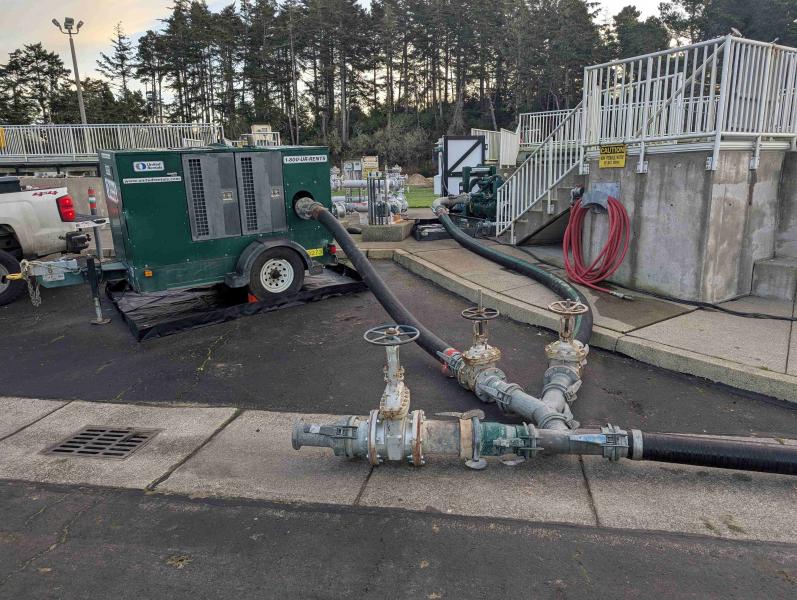
November 8th, 2024
Our contractor, Strider Construction and their concrete specialty subcontractor, Cascade Civil, poured one of the UV channel walls on Wednesday. The concrete pour was approximately 12 cubic yards of concrete. They are currently scheduled for another concrete wall pour next week with 22 cubic yards.
April 19th, 2024
The contractor has formed up the north and south end bottom slabs of the new effluent channel and placed rebar in them. The contractor is planning on pouring concrete Friday, April 19th, along with the pad for the new transformer.
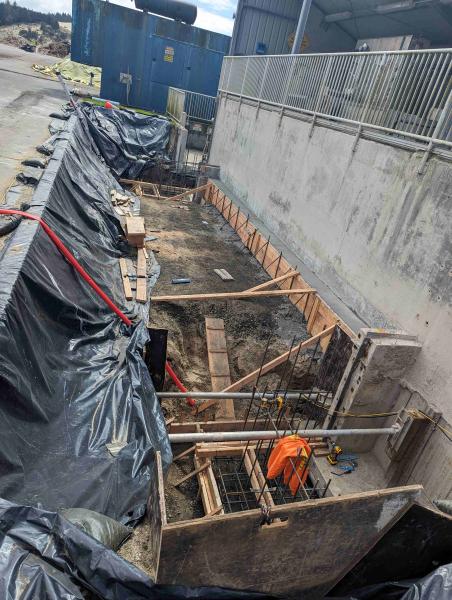
April 5th, 2024
Saw cutting of the footing on the old UV system took longer than expected, so the contractor will begin forming for the new UV structure the week of April 5th.
March 29th, 2024
The contractor completed most of the excavation and are dewatering to stabilize the excavation until they are able to form for the new concrete walls. The contractor is hopeful to begin forming for the new UV structure the week of April 1st.
March 22nd, 2024
Our contractor has started to excavate for the new UV structure at the Wastewater Treatment Plant (WWTP). As the contractor was excavating, we discovered some additional concrete next to the existing UV structure. The contractor also found the old chlorination pipe that was used to disinfect the effluent before the UV system was installed in 1999/2000.
